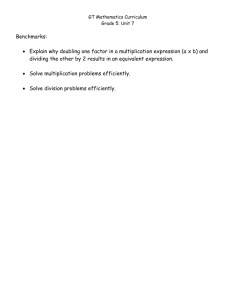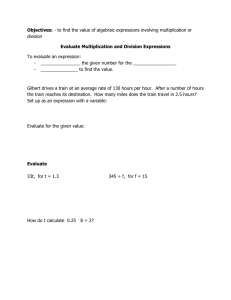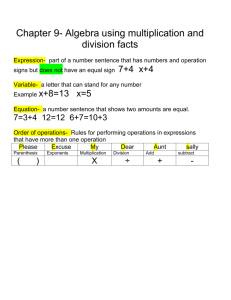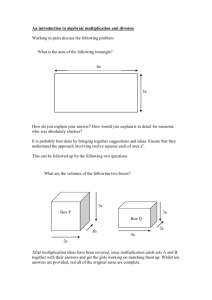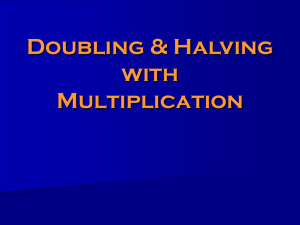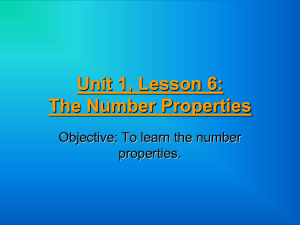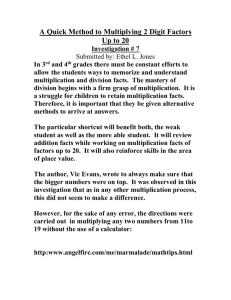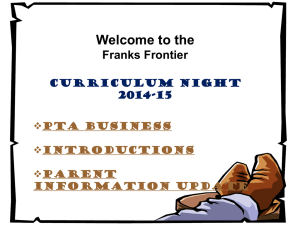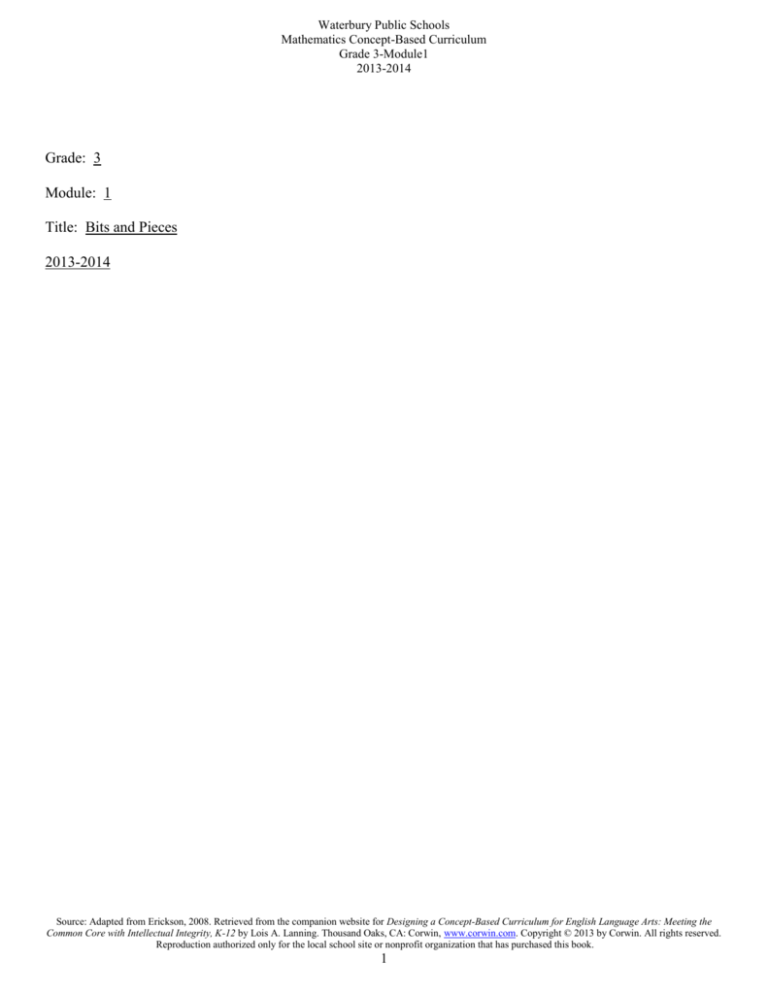
Waterbury Public Schools
Mathematics Concept-Based Curriculum
Grade 3-Module1
2013-2014
Grade: 3
Module: 1
Title: Bits and Pieces
2013-2014
Source: Adapted from Erickson, 2008. Retrieved from the companion website for Designing a Concept-Based Curriculum for English Language Arts: Meeting the
Common Core with Intellectual Integrity, K-12 by Lois A. Lanning. Thousand Oaks, CA: Corwin, www.corwin.com. Copyright © 2013 by Corwin. All rights reserved.
Reproduction authorized only for the local school site or nonprofit organization that has purchased this book.
1
Waterbury Public Schools
Mathematics Concept-Based Curriculum
Grade 3-Module1
2013-2014
Module 1 Title: Bits and Pieces
Conceptual Lens: Connections
Division (D)
Inverse Operation
Repeated Subtraction
Symbols
Quotients
Divisors
Dividends
Equations
Fluency
Mental Math
Story Problems
Equal Shares
Partitioning
Multiplication (M)
Commutative Property
Distributive Property
Associative Property
Zero Property
Identity Property
Products
Factors
Decomposing Factors
Multiples
Inverse Operation
Repeated Addition
Symbols
Equations
Fluency
Mental Math
Story Problems
Models (MO)
Concrete
Pictorial
Representations
Abstract
Module 1 Title:
Bits and Pieces
Patterns (P)
Equal Shares
Skip Counting
Even/Odd
Fact Families
Data (DA)
Bar Graph
Pictograph
Measurement
Source: Adapted from Erickson, 2008. Retrieved from the companion website for Designing a Concept-Based Curriculum for English Language Arts: Meeting the
Common Core with Intellectual Integrity, K-12 by Lois A. Lanning. Thousand Oaks, CA: Corwin, www.corwin.com. Copyright © 2013 by Corwin. All rights reserved.
Reproduction authorized only for the local school site or nonprofit organization that has purchased this book.
2
Waterbury Public Schools
Mathematics Concept-Based Curriculum
Grade 3-Module1
2013-2014
Module Title: Bits and Pieces
Conceptual Lens: Patterns
Module Overview
In this module, you will develop an understanding of the meanings of multiplication and division and the relationship between the two
operations. You will apply properties of operations through activities involving equal-sized groups, arrays, and area models. You will
develop strategies to find unknown factors and products in multiplication. For equal-sized group situations, division can require
finding the unknown number of groups or the unknown group size.
Technology Integration
Teachers should be proficient utilizing interactive whiteboard technology and internet resources such as ThinkCentral.com and other
websites that provide interactive math tools. Also, teachers should demonstrate knowledge of administering online testing, interpreting
data, and selecting computer based activities for students.
Standards for Mathematical Content addressed in this Module
3.OA.1
3.OA.2
3.OA.3
3.OA.4
3.OA.5
3.OA.6
3.OA.7
3.MD.3
Standards for Mathematical Practice addressed in this module:
1. Make sense of problems and persevere in solving them.
2. Reason abstractly and quantitatively.
3. Construct viable arguments and critique the reasoning of others.
4. Model with mathematics.
5. Use appropriate tools strategically.
6. Attend to precision.
7. Look for and make use of structure.
8. Look for and express regularity in repeated reasoning.
Source: Adapted from Erickson, 2008. Retrieved from the companion website for Designing a Concept-Based Curriculum for English Language Arts: Meeting the
Common Core with Intellectual Integrity, K-12 by Lois A. Lanning. Thousand Oaks, CA: Corwin, www.corwin.com. Copyright © 2013 by Corwin. All rights reserved.
Reproduction authorized only for the local school site or nonprofit organization that has purchased this book.
3
Waterbury Public Schools
Mathematics Concept-Based Curriculum
Grade 3-Module1
2013-2014
Guiding Questions
Generalizations
(F = factual; C = conceptual; P = philosophical)
1. Analyzing patterns in multiplication
and division develops computational
fluency.
(M,D)
a.
b.
c.
d.
e.
f.
g.
h.
2. Multiplication refers to n groups of the
same size.
(M)
a.
b.
3. Multiplication and division are inverse
operations.
(M,D,MO,P)
a.
b.
c.
d.
e.
f.
g.
What strategies will help me add multiple, repeated, numbers quickly
and accurately? (6+6+6+6+6=30) (C)
What patterns do I notice when I am multiplying basic facts? (C)
What patterns do I notice when I am dividing? (C)
How can we use patterns to solve problems? (P)
How can we use multiplication patterns to determine the identity of
missing numbers in a multiplication table? (C)
How can you use a number line to relate repeated addition to
multiplication? (C)
What are the factors of a number (i.e. 12)? (F)
What are the first three multiples of a number (i.e. 2)? (F)
What is the product when you have five groups of six? (F)
What strategies can we use to efficiently solve multiplication problems?
(C)
c. What is the missing factor when 3 x n = 12? (F)
d. How many different factors can you find in this number? (F)
e. How does knowing the associative property help us multiply numbers
easily and quickly? (F)
f. What multiplication fact is shown on this number line? (F)
g. How is zero different from any other whole number you might multiply?
(C)
h. How is one different from any other whole number you might
multiply?(C)
i. How are multiplication and addition alike/different? (C)
j. How can multiplication be used to solve real world problems? (C)
k. How can we connect multiplication facts with their array models? (C)
l. How can we model multiplication? (C)
m. Which four facts does this array show? (F)
n. How can we write an equation to represent this model? (C)
o. Is there more than one way of multiplying to get the same product? (C)
p. How can we practice multiplication facts in a meaningful way that will
help us remember them? (F)
q. How does drawing an array help us think about different ways to
decompose a number? (C)
r. What do the factors in square arrays have in common? (F)
h.
How are multiplication and division related? (P)
What is an inverse operation? (F)
What is the inverse operation of multiplication/division? (F)
How can we use division to check a multiplication answer? (C)
How can we use multiplication to check a division answer? (C)
How can the same array represent both multiplication and division? (C)
How can use this fact to demonstrate that multiplication is the inverse of
division? (C)
What four equations are pictured in this array? (F)
Source: Adapted from Erickson, 2008. Retrieved from the companion website for Designing a Concept-Based Curriculum for English Language Arts: Meeting the
Common Core with Intellectual Integrity, K-12 by Lois A. Lanning. Thousand Oaks, CA: Corwin, www.corwin.com. Copyright © 2013 by Corwin. All rights reserved.
Reproduction authorized only for the local school site or nonprofit organization that has purchased this book.
4
Waterbury Public Schools
Mathematics Concept-Based Curriculum
Grade 3-Module1
2013-2014
i.
What do the parts of a division problem represent? (F)
How can we use repeated subtraction to solve a division problem? (C)
What similarities/differences do you see in division and subtraction? (C)
What happens to the quotient when the dividend increases or decreases?
(C)
What is the relationship between the divisor and the quotient? (C)
How do the parts of a division problem relate to each other? (C)
How can we write an equation to represent division models we have
made? (C)
How does drawing an array help us think about different ways to
decompose a number? (C)
How can you write a division equation to match this model?(F)
5. Graphs represent data.
(D)
a.
b.
c.
d.
e.
f.
g.
How can you use graphs to answer a question? (C)
How can surveys be used to collect data?(C)
How do I decide what increments to use for my scale? (C)
How can data be used to make decisions? (P)
How can data displayed in tables and graphs be used to inform? (C)
How can graphs be used to compare related data? (C)
How do you display collected data? (F)
6. Word problems contain information
that directs you to a problem solving
plan.
(M,D,MO,P,DA)
a.
b.
What is the problem asking you to do? (C)
How can you use the situation in a word problem to determine the
best operation to use? (C)
How is an unknown represented in an equation? (F)
How can you determine what is unknown in a word problem? (C)
How can you make an equation with an unknown when you have a
multistep word problem? (C)
How can we use patterns to solve problems? (P)
4. Division refers to either equal parts or
number of shares.
(D)
a.
b.
c.
d.
e.
f.
g.
h.
c.
d.
e.
f.
7. Effective mathematicians utilize
appropriate tools and strategies to solve
problems and justify solutions.
(M,D,MO,P,DA)
a.
b.
c.
d.
e.
f.
g.
h.
i.
How does using inverse operations help us multiply and divide?(C)
How can I learn to effectively calculate products and quotients in my
head? (C)
How does mental math help us calculate quickly and develop and
internal sense of numbers?(C)
How can skip counting a number line help us multiply or divide? (C)
What strategies can we use to efficiently solve multiplication problems?
(C)
How can you prove that your solution is valid? (C)
How can you justify that the solution is not valid? (C)
How can we use multiplication patterns to determine the identity of
missing numbers in a multiplication table? (C)
How does drawing an array help us think about different ways to
decompose a number? (C)
Source: Adapted from Erickson, 2008. Retrieved from the companion website for Designing a Concept-Based Curriculum for English Language Arts: Meeting the
Common Core with Intellectual Integrity, K-12 by Lois A. Lanning. Thousand Oaks, CA: Corwin, www.corwin.com. Copyright © 2013 by Corwin. All rights reserved.
Reproduction authorized only for the local school site or nonprofit organization that has purchased this book.
5
Waterbury Public Schools
Mathematics Concept-Based Curriculum
Grade 3-Module1
2013-2014
Critical Content and Key Skills
Critical Content
What Students Will Know
Multiplication:
Use properties to multiply
Use multiple strategies to solve multiplication
equations
Use symbols appropriately
Mental math to build fluency
Division
Use properties to divide
Use multiple strategies to solve division
equations
Use symbols appropriately
Mental math to build fluency
Models
Use models to solve multiplication and
division situations and equations
Use models to analyze data
Patterns
Use patterns to solve multiplication and
division situations and equations
Data
Use appropriate data representations properly
Key Skills
What Students Will Be Able to Do
3.OA.1 Interpret products of whole numbers, e.g., interpret 5 × 7 as the
total number of objects in 5 groups of objects each. For example, describe
a context in which a total number of objects can be expressed as 5×7.
3.OA.2 Interpret whole-number quotients of whole numbers, e.g., interpret
56 ÷ 8 as the number of objects in each share when 56 objects are
partitioned equally into 8 shares, or as a number of shares when 56 objects
are partitioned into equal shares of 8 objects each. For example, describe a
context in which a number of shares or a number of groups can be
expressed as 56 ÷ 8.
3.OA.3 Use multiplication and division within 100 to solve word
problems in situations involving equal groups, arrays, and measurement
quantities, e.g., by using drawings and equations with a symbol for the
unknown number to represent the problem.
3.OA.4 Determine the unknown whole number in a multiplication or
division equation relating three whole numbers. For example, determine
the unknown number that makes the equation true in each of the equations
8 × ? = 48, 5 = � ÷ 3, 6 × 6 = ?.
3.OA.5 Apply properties of operations as strategies to multiply and
divide.2 Examples: If 6 × 4 = 24 is known, then 4 × 6 = 24 is also known.
(Commutative property of multiplication.) 3 × 5 × 2 can be found by
3 × 5 = 15, then 15 × 2 = 30, or by 5 × 2 = 10, then 3 × 10 = 30.
(Associative property of Multiplication.) Knowing that 8 × 5 = 40 and 8
× 2 = 16, one can find 8 × 7 as 8 × (5 + 2) =
(8 × 5) + (8 × 2) = 40 + 16 = 56. (Distributive property.)
3.OA.6 Understand division as an unknown-factor problem. For example,
find 32 ÷ 8 by finding the number that makes 32 when multiplied by 8.
3.OA.7 Fluently multiply and divide within 100, using strategies such as
the relationship between multiplication and division (e.g., knowing that 8
× 5 = 40, one knows 40 ÷ 5 = 8) or properties of operations. By the end of
Grade 3, know from memory all products of two one-digit numbers.
3.MD.3 Draw a scaled picture graph and a scaled bar graph to represent a
data set with several categories. Solve one-and two-step “how many more”
and “how many less” problems using information presented in scaled bar
graphs. For example, draw a bar graph in which each square in the bar
graph might represent 5 pets.
Source: Adapted from Erickson, 2008. Retrieved from the companion website for Designing a Concept-Based Curriculum for English Language Arts: Meeting the
Common Core with Intellectual Integrity, K-12 by Lois A. Lanning. Thousand Oaks, CA: Corwin, www.corwin.com. Copyright © 2013 by Corwin. All rights reserved.
Reproduction authorized only for the local school site or nonprofit organization that has purchased this book.
6
Waterbury Public Schools
Mathematics Concept-Based Curriculum
Grade 3-Module1
2013-2014
Suggested
Timeline
Spiral
throughout
this module.
Assessments
(Suggested and
Required**)
Learning Experiences
Model the process of solving word problems involving all
four operations. Move from single step to multi-step.
(Problems should involve unknowns in different positions).
G: (6, 3, 4)
**All learning experiences allow for student discourse.
Teacher Observations
Math Expressions
Formative Assessment:
On-Going Assessments
Quick Quizzes
Unit Tests
Differentiation
(For Support and
Extension)
Math Expressions
Refer to Differentiated
Instruction pages in T.E.
or on ThinkCentral.
Resources
Hands-On Standards®,
Common Core Edition, Grade 4.
ETA hand2mind, © 2012.
Intervention Cards
Challenge Cards
Intervention: Online Soar
to Success
Extension: Online
Destination Math
Source: Adapted from Erickson, 2008. Retrieved from the companion website for Designing a Concept-Based Curriculum for English Language Arts: Meeting the Common Core with Intellectual Integrity, K-12 by Lois A.
Lanning. Thousand Oaks, CA: Corwin, www.corwin.com. Copyright © 2013 by Corwin. All rights reserved. Reproduction authorized only for the local school site or nonprofit organization that has purchased this book.
7
Waterbury Public Schools
Mathematics Concept-Based Curriculum
Grade 3-Module1
2013-2014
Learning
Experiences
Suggested
Timeline
Days 1- 15
Assessments
(Suggested and
Required**)
Model multiplication situations with concrete objects
(i.e. counters, unifix cubes, square tiles, kinesthetic,
etc.). Then, move on to pictorial representations (i.e.,
arrays, drawings, etc.). Lastly, move on to equations.
** Performance Task
(End of Module)
Have students build equal groups, arrays, etc. with
concrete objects. (5x3 is the same as 5 groups of 3, etc.)
(G: 2, 1, 7)
Math Expressions
Formative Assessment:
Ongoing Assessments
Quick Quiz
Unit Tests
Have students model the Distributive Property.
Teacher Observation
Differentiation
(For Support and
Extension)
Resources
Math Expressions
Units 7 and 9: refer to
Differentiated Instruction pages
in T.E. or on Think Central
Grade 3 Unpacked Standards
Intervention: Online Soar to
Success
www.eduplace.com
Extension: Online Destination
Math
Math Expressions
Units 7 and 9
Hands On Standards Common Core
Gr. 3, ETA hand2mind @ 2012
Think Central:
iTools Primary
Mega Math
Mastering the Basic Math Facts in
Multiplication and Division,
O’Connell, SanGiovanni, © 2011
LearnZillion - Drawing Arrays
LearnZillion - Skip Counting
LearnZillion - Repeated Addition
Module One Lessons (see attached)
What’s My Product
Engageny.org/resource/grade-3mathematics-module-1
Continued
Source: Adapted from Erickson, 2008. Retrieved from the companion website for Designing a Concept-Based Curriculum for English Language Arts: Meeting the Common Core with Intellectual Integrity, K-12 by Lois A.
Lanning. Thousand Oaks, CA: Corwin, www.corwin.com. Copyright © 2013 by Corwin. All rights reserved. Reproduction authorized only for the local school site or nonprofit organization that has purchased this book.
8
Waterbury Public Schools
Mathematics Concept-Based Curriculum
Grade 3-Module1
2013-2014
Have students represent skip counting on a number line.
(G: 1, 2)
Have students solve multiplication equations several
different ways. Students can fold a paper into fourths and
demonstrate skip counting, repeated addition, arrays and
equal groups.
G: (1)
Demonstrate that while the order of the factors does not
change the product, their representations of arrays and
groups would look different.
G:(1, 3, 5)
**All learning experiences allow for student discourse.
Source: Adapted from Erickson, 2008. Retrieved from the companion website for Designing a Concept-Based Curriculum for English Language Arts: Meeting the Common Core with Intellectual Integrity, K-12 by Lois A.
Lanning. Thousand Oaks, CA: Corwin, www.corwin.com. Copyright © 2013 by Corwin. All rights reserved. Reproduction authorized only for the local school site or nonprofit organization that has purchased this book.
9
Waterbury Public Schools
Mathematics Concept-Based Curriculum
Grade 3-Module1
2013-2014
Suggested
Timeline
Days 16-33
Learning
Experiences
Model division situations with concrete objects (i.e. counters, unifix
cubes, square tiles, kinesthetic, etc.). Then, move on to pictorial
representations (i.e., arrays, drawings, etc.). Lastly, move on to
equations.
Model that division is represented in two different situations. Have
students break total into equal groups, arrays, etc. with concrete objects.
(G: 4, 3)
Partitive (Equal groups):
determining how many objects
are in each group.
Assessments
(Suggested and
Required**)
Differentiation (For
Support and
Extension)
Teacher Observation
Math Expressions
Units 7 and 9: refer to
Differentiated
Instruction pages in
T.E. or on Think
Central
Grade 3 Unpacked Standards
Intervention: Online
Soar to Success
Hands On Standards Common
Core Gr. 3, ETA hand2mind @
2012
Math Expressions
Formative Assessment:
Ongoing Assessments
Quick Quiz
Unit Tests
Extension: Online
Destination Math
I have 12 apples. I put them in 4 bags. How many are in each bag?
12÷4=3
Resources
Math Expressions
Units 7 and 9
www.eduplace.com
Think Central:
iTools Primary
Mega Math
Mastering the Basic Math Facts in
Multiplication and Division,
O’Connell, SanGiovanni, © 2011
Quotative (Measurement):
determining how many groups can be made from a specific
amount of equal objects. This is repeated subtraction.
LearnZillion - Subtracting Equal
Groups
I have 12 apples. I want to put 4 in each bag. How many bags do I
need?
12÷4=3
LearnZillion - Drawing Pictures
Module One Lessons (see attached)
Stuck on Division
Sharing Pumpkin Seeds
Discuss patterns in division. Have students represent repeated
subtraction on a number line. (G: 1, 4)
Have students solve division equations several different ways. Students
can fold a paper into fourths and demonstrate skip counting, repeated
subtraction, arrays and equal groups. G: (4, 7)
** All learning experiences allow for student discourse.
Source: Adapted from Erickson, 2008. Retrieved from the companion website for Designing a Concept-Based Curriculum for English Language Arts: Meeting the Common Core with Intellectual Integrity, K-12 by Lois A.
Lanning. Thousand Oaks, CA: Corwin, www.corwin.com. Copyright © 2013 by Corwin. All rights reserved. Reproduction authorized only for the local school site or nonprofit organization that has purchased this book.
10
Waterbury Public Schools
Mathematics Concept-Based Curriculum
Grade 3-Module1
2013-2014
Suggested
Timeline
Days 34-38
Learning
Experiences
Model multiplication and division story problems
with concrete objects (i.e. counters, unifix cubes,
square tiles, kinesthetic, etc.). Then, move on to
pictorial representations (i.e., arrays, drawings,
etc.). Lastly, move on to equations.
G: (6, 3, 4)
Assessments (Suggested
and Required**)
Teacher Observation
Math Expressions
Formative Assessment:
Ongoing Assessments
Quick Quiz
Unit Tests
Refer to all multiplications and division strategies
listed above and apply them to story problem
situations.
Differentiation (For
Support and Extension)
Math Expressions
Units 7 and 9: refer to
Differentiated Instruction
pages in T.E. or on Think
Central
Grade 3 Unpacked Standards
Math Expressions
Unit 7 and 9
www.eduplace.com
Intervention: Online Soar to
Success
Extension: Online
Destination Math
** All learning experiences allow for student
discourse.
Resources
Hands On Standards Common Core Gr.
3, ETA hand2mind @ 2012
Think Central:
iTools Primary
Mega Math
Mastering the Basic Math Facts in
Multiplication and Division, O’Connell,
SanGiovanni, © 2011
LearnZillion - Using a Diagram
Source: Adapted from Erickson, 2008. Retrieved from the companion website for Designing a Concept-Based Curriculum for English Language Arts: Meeting the Common Core with Intellectual Integrity, K-12 by Lois A.
Lanning. Thousand Oaks, CA: Corwin, www.corwin.com. Copyright © 2013 by Corwin. All rights reserved. Reproduction authorized only for the local school site or nonprofit organization that has purchased this book.
11
Waterbury Public Schools
Mathematics Concept-Based Curriculum
Grade 3-Module1
2013-2014
Suggested
Timeline
Learning
Experiences
Days 39-42
Model data analysis situations with concrete objects
(i.e. sticky notes, unifix cubes, square tiles,
kinesthetic, etc.). Then, move on to pictorial
representations (i.e. pictograph and bar graphs).
Have students create scaled pictographs and bar graphs
based on a given set of data. (ie: Draw a bar graph
where each square equals 3birds.)
G: (5, 2)
Have students make comparisons based on pictographs
and bar graphs.
Assessments (Suggested
and Required**)
Teacher Observation
Math Expressions
Formative Assessment:
Ongoing Assessments
Quick Quiz
Unit Tests
Differentiation (For
Support and Extension)
Resources
Math Expressions
Units 5 and 9: refer to
Differentiated Instruction
pages in T.E. or on Think
Central
Grade 3 Unpacked Standards
Intervention: Online Soar to
Success
www.eduplace.com
** Performance Task
Extension: Online
Destination Math
Math Expressions
Unit 5:Lessons 15, 16
Unit 9: Lesson 7
Hands On Standards Common Core Gr.
3, ETA hand2mind @ 2012
Think Central:
iTools Primary
Mega Math
Call attention to the fact that when determining
interval they are skip counting by a certain increments
which is related to multiplication.
Mastering the Basic Math Facts in
Multiplication and Division, O’Connell,
SanGiovanni, © 2011
** All learning experiences allow for student
discourse.
Module One Lessons (see attached)
Animal Investigation
Ice Cream Scoops
Source: Adapted from Erickson, 2008. Retrieved from the companion website for Designing a Concept-Based Curriculum for English Language Arts: Meeting the Common Core with Intellectual Integrity, K-12 by Lois A.
Lanning. Thousand Oaks, CA: Corwin, www.corwin.com. Copyright © 2013 by Corwin. All rights reserved. Reproduction authorized only for the local school site or nonprofit organization that has purchased this book.
12
Grade 3 Module 1 Performance Task
WHAT?
WHY?
HOW?
Materials:
Assessment Procedure:
Georgia Department of Education
Common Core Georgia Performance Standards Framework
Third Grade Mathematics
SCAFFOLDING TASK: What’s My Product?
STANDARDS OF MATHEMATICAL CONTENT
MCC.3.OA.1. Interpret products of whole numbers, e.g., interpret 5 × 7 as the
total number of objects in 5 groups of 7 objects each. For example, describe a
context in which a total number of objects can be expressed as 5 × 7.
STANDARDS FOR MATHEMATICAL PRACTICE
1. Make sense of problems and persevere in solving them.
2. Reason abstractly and quantitatively.
3. Construct viable arguments and critique the reasoning of others.
4. Model with mathematics.
5. Use appropriate tools strategically.
6. Attend to precision.
7. Look for and make use of structure.
8. Look for and express regularity in repeated reasoning.
BACKGROUND KNOWLEDGE
Traditionally multiplication tables are emphasized when students begin learning about
multiplication. Students are sent home with flash cards without a true understanding of what
multiplication is. This way of learning multiplication can be difficult for students to understand.
Naturally, students make groups and groups of groups. The creation of groups is a way to find the
total of something in the most efficient way. The following activity allows students to build on
their natural ability to form groups and learn multiplication without memorizing facts in isolation,
but as number facts that can be related to each other in a multitude of ways (Frans van Galen and
Catherine Twomey Fosnot, 2007, Context for Learning Mathematics).
•
•
•
ESSENTIAL QUESTIONS
What are the strategies for learning multiplication?
How can we practice multiplication facts in a meaningful way that will help us remember them?
How is the commutative property of multiplication evident in an array model?
MATERIALS
•
•
•
Colored tiles or two-sided counters
Something to help organize groups such as paper plates, cups, bowls, etc.
“What’s My Product” recording sheet
MATHEMATICS
GRADE 3
Georgia Department of Education
Dr. John D. Barge, State School Superintendent May 2012
All Rights Reserved
Georgia Department of Education
Common Core Georgia Performance Standards Framework
Third Grade Mathematics
GROUPING
Individual/Partners
TASK DESCRIPTION, DEVELOPMENT AND DISCUSSION
This task allows students to interpret products of whole numbers by creating equal groups with
manipulatives.
Task Directions Part
I
Discuss with students how to group objects. Show a container of 20 counters. Discuss with
students an easy way to count the total number of counters in the container. Have students
arrange the counters into equal groups. As students discuss how to put the 20 counters into groups
write their thinking on the board. Explain to students that in a multiplication problem one number
represents the number of groups and the other number represents the number of objects in a group.
Part II
Provide students with a given a set of counters or tiles to separate into equal groups.
The students will continue to rearrange tiles into different groupings that are equal. As each
group is arranged, write a multiplication fact to match the arrangement. Students will record
their thinking in the “What’s My Product?” recording Sheet.
FORMATIVE ASSESSMENT QUESTIONS
•
•
•
•
How many ways were you able to organize the number of counters you were given?
Can you think of another way to organize your counters?
What does your number sentence look like?
How can you explain your picture and number sentence in words?
DIFFERENTIATION
Extension
•
Increase the numbers of counters in the students’ baggies.
•
Intervention
Provide smaller numbers of counters and allow students to work with a partner.
MATHEMATICS
GRADE 3
Georgia Department of Education
Dr. John D. Barge, State School Superintendent May 2012
All Rights Reserved
Georgia Department of Education
Common Core Georgia Performance Standards Framework
Third Grade Mathematics
Name
_Date
What’s My Product?
Directions: Arrange counters into equal groups. Complete the table below with
your arrangements.
Groups
# of Tiles/Counters
Multiplication
Fact
MATHEMATICS
GRADE 3
Georgia Department of Education
Dr. John D. Barge, State School Superintendent May 2012
All Rights Reserved
Total
Georgia Department of Education
Common Core Georgia Performance Standards Framework
Third Grade Mathematics
CONSTRUCTING TASK: Stamp Shortage
STANDARDS FOR MATHEMATICAL CONTENT
MCC.3.OA.3 Use multiplication and division within 100 to solve word problems in situations
involving equal groups, arrays, and measurement quantities, e.g., by using drawings and
equations with a symbol for the unknown number to represent the problem.
MCC. 3.OA.4 Determine the unknown whole number in a multiplication or division
equation relating three whole numbers.
STANDARDS FOR MATHEMATICAL PRACTICE
1. Make sense of problems and persevere in solving them.
2. Reason abstractly and quantitatively.
3. Construct viable arguments and critique the reasoning of others.
4. Model with mathematics.
5. Use appropriate tools strategically.
6. Attend to precision.
7. Look for and make use of structure.
8. Look for and express regularity in repeated reasoning.
BACKGROUND KNOWLEDGE
Often the first strategy students use to solve multiplication problems is repeated addition.
This is because they are viewing the situation additively. Repeated addition should be
seen as a starting place in the journey to understanding multiplication. (Context for
Learning Mathematics, Frans van Galen and Catherine Twomey Fosnot, 2007. In this
task, students explore other strategies to solve multiplication and division strategies.
•
ESSENTIAL QUESTIONS
What are the strategies for learning multiplication?
MATERIALS
•
•
•
drawing paper
money
“Stamp Shortage” recording sheet
GROUPING
Individual/Partners
TASK DESCRIPTION, DEVELOPMENT AND DISCUSSION
MATHEMATICS
GRADE 3
Georgia Department of Education
Dr. John D. Barge, State School Superintendent May 2012
All Rights Reserved
Georgia Department of Education
Common Core Georgia Performance Standards Framework
Third Grade Mathematics
Students will follow the directions on the “Stamp Shortage” recording sheet. Encourage students
to show their work using pictures, charts, or tables.
The local grocery store has run out of 47¢ stamps. The only stamps left are 2¢, 3¢, and
4¢. How many different combinations of stamps can be used to make 47¢?
•
•
•
•
FORMATIVE ASSESSMENT QUESTIONS
How could division help you solve this problem?
How could multiplication help you solve this problem?
How could estimation help you solve this problem?
Is this the only solution? Can you solve it another way?
DIFFERENTIATION
•
Extension
Allow students to create their own stamps and vary the prices.
•
Intervention
Allow students to work with a small group and provide money and stamps (or stamp cut outs,
counters, etc.) as manipulatives.
MATHEMATICS
GRADE 3
Georgia Department of Education
Dr. John D. Barge, State School Superintendent May 2012
All Rights Reserved
Georgia Department of Education
Common Core Georgia Performance Standards Framework
Third Grade Mathematics
Name
Date
Stamp Shortage
The local grocery store has run out of 47¢ stamps. The only stamps left are 2¢,
3¢, and 4¢. How many different combinations of stamps can be used to make 47¢?
Solve the above problem. Show all your work using drawings, charts, and/or tables.
MATHEMATICS
GRADE 3
Georgia Department of Education
Dr. John D. Barge, State School Superintendent May 2012
All Rights Reserved
Georgia Department of Education
Common Core Georgia Performance Standards Framework
Third Grade Mathematics
CONSTRUCTING TASK: Sharing Pumpkin Seeds STANDARDS
OF MATNEMATICAL CONTENT
MCC.3.OA.2 Interpret whole-number quotients of whole numbers, e.g.,
interpret 56 ÷ 8 as the number of objects in each share when 56 objects are
partitioned equally into 8 shares, or as a number of shares when 56 objects are
partitioned into equal shares of 8 objects each.
MCC.3.OA.3 Use multiplication and division within 100 to solve word
problems in situations involving equal groups, arrays, and measurement
quantities, e.g., by using drawings and equations with a symbol for the unknown
number to represent the problem.
STANDARDS OF MATHEMATICAL PRACTICE
1.
2.
3.
4.
5.
6.
7.
8.
Make sense of problems and persevere in solving them.
Reason abstractly and quantitatively.
Construct viable arguments and critique the reasoning of others.
Model with mathematics.
Use appropriate tools strategically.
Attend to precision.
Look for and make use of structure.
Look for and express regularity in repeated reasoning.
BACKGROUND KNOWLEDGE
This task provides students with an opportunity to develop and discuss strategies for dividing
a two- or three-digit number by a one-digit number. Possible strategies students may use to solve
this type of problem include, using base 10 blocks, using their knowledge of multiplication and
inverse operations, or using repeated subtraction. Third grade is students’ first exposure to larger
number division and it is important to allow students time to make sense of this operation, so that
students will continue to be successful with division in later grades.
ESSENTIAL QUESTIONS
•
•
•
How can we divide larger numbers?
What is the meaning of a remainder?
Does a remainder mean the same thing in every division problem?
MATERIALS
•
•
“Sharing Pumpkin Seeds” recording sheet
Base 10 blocks or other materials for counting available for students who wish to use them
MATHEMATICS
GRADE 3
Georgia Department of Education
Dr. John D. Barge, State School Superintendent May 2012
All Rights Reserved
Georgia Department of Education
Common Core Georgia Performance Standards Framework
Third Grade Mathematics
•
How Many Seeds in a Pumpkin? by Margaret McNamara or similar book
GROUPING
Individual/Partner Task
TASK DESCRIPTION, DEVELOPMENT AND DISCUSSION
In this task, students will decide how to share pumpkin seeds fairly with a group of children.
Comments
This task can be paired with the following science standard: S3L1b. Identify features of
green plants that allow them to live and thrive in different regions of Georgia.
There are many children’s books about pumpkins and pumpkin seeds, any one of them could
be used as an introduction to this task. One book that deals directly with the number of seeds
in a pumpkin is How Many Seeds in a Pumpkin? by Margaret McNamara, Illustrated by G.
Brian Karas.
Task Directions
Students will solve the two sharing problems on the “Sharing Pumpkin Seeds” recording
sheet.
Problem 1
Ben and his 3 friends toasted 80 pumpkin seeds from their pumpkin. How many seeds
will each child get if they share the pumpkin seeds fairly?
Clearly explain your thinking using words, numbers, and/or pictures.
Students may approach the problem 80 ÷4 in a variety of ways. Some students may build on their
understanding of multiplication as the inverse of division to solve the problem.
Example 1
I know 4 x 2 = 8, so 4 x 20 = 80. If I add 4 groups of 20, I know there are a total of 80.
Therefore, each child will get 20 pumpkin seeds.
Other students may build on their understanding of division as repeated subtraction.
Example 2
4 x 10 = 40
80-40 = 40
Each child got 10 pumpkin seeds.
4 x 10 = 40
Each child got 10 more pumpkin seeds.
40– 40 = 0
Each child received a total of 10 + 10 pumpkin seeds or 20 pumpkin seeds.
Some students may choose to use base 10 blocks to represent the division problem.
MATHEMATICS
GRADE 3
Georgia Department of Education
Dr. John D. Barge, State School Superintendent May 2012
All Rights Reserved
Georgia Department of Education
Common Core Georgia Performance Standards Framework
Third Grade Mathematics
Example 3
First I took out blocks equal to 80.
Then I started sharing the ten strips among four groups.
Comments
After students have had plenty of time to develop an understanding of division using a
method that makes sense to them, begin to talk with students about an efficient way to record
the various strategies they now use.
MATHEMATICS
GRADE 3
Georgia Department of Education
Dr. John D. Barge, State School Superintendent May 2012
All Rights Reserved
Georgia Department of Education
Common Core Georgia Performance Standards Framework
Third Grade Mathematics
•
•
•
FORMATIVE ASSESSMENT QUESTIONS
What is your plan to solve this problem?
How do you know your answer is correct?
How does this help you answer the question in the problem?
DIFFERENTIATION
Extension
Have students to compare strategies used to solve each problem. Encourage them to look
for similarities and differences in their approaches to the problem and to discuss the efficiency
of each. Ask students to present their findings to the class.
Intervention
Before asking students to solve the problems on the “Sharing Pumpkin Seeds” recording
sheet, be sure students have been able to solve similar problems with two-digit dividends.
TECHNOLOGY CONNECTION
http://mason.gmu.edu/~mmankus/whole/base10/asmdb10.htm#div A site for teachers and parents
provides information on using base 10 blocks to solve division problems with an area model.
MATHEMATICS
GRADE 3
Georgia Department of Education
Dr. John D. Barge, State School Superintendent May 2012
All Rights Reserved
Georgia Department of Education
Common Core Georgia Performance Standards Framework
Third Grade Mathematics
Name
_Date _
Sharing Pumpkin Seeds
Ben and his 3 friends toasted 80 pumpkin seeds from their pumpkin. How many
seeds will each child get if they share the pumpkin seeds fairly? Clearly
explain your thinking using words, numbers, and/or pictures.
Sarah and her 5 friends toasted 96 pumpkin seeds from their pumpkin. How many
seeds will each child get if they share the pumpkin seeds fairly? Clearly explain your
thinking using words, numbers, and/or pictures.
MATHEMATICS
GRADE 3
Georgia Department of Education
Dr. John D. Barge, State School Superintendent May 2012
All Rights Reserved
Georgia Department of Education
Common Core Georgia Performance Standards Framework
Third Grade Mathematics
SCAFFOLDING TASK: Animal Investigation STANDARDS
FOR MATHEMATICAL CONTENT
MCC.3.MD.3. Draw a scaled picture graph and a scaled bar graph to represent a data set with
several categories. Solve one- and two-step “how many more” and “how many less” problems using
information presented in scaled bar graphs. For example, draw a bar graph in which each square in
the bar graph might represent 5 pets.
STANDARDS FOR MATHEMATICAL PRACTICE
1.
2.
3.
4.
5.
6.
7.
8.
Make sense of problems and persevere in solving them.
Reason abstractly and quantitatively.
Construct viable arguments and critique the reasoning of others.
Model with mathematics.
Use appropriate tools strategically.
Attend to precision.
Look for and make use of structure.
Look for and express regularity in repeated reasoning.
BACKGROUND KNOWLEDGE
Students should develop questions that can be aligned with data and collect, organize, and display
data in different ways. Data collection should be for a purpose such as answering a question.
The analysis of data should have the agenda of adding information about some aspect of our
world. (Teaching Student-Centered Mathematics, John A. Van de Walle and LouAnn H. Lovin,
2007). In this activity students will create picture graphs and bar graphs for a data set and
interpret what the data means.
ESSENTIAL QUESTIONS
•
•
•
•
How do I decide what increment scale to use for a bar graph?
How do you interpret data in a graph?
How can I show data using a line plot graph?
How do I decide what symbol to use when constructing a pictograph?
MATERIALS
•
Chart paper/graphing paper
GROUPING
Individual/Partner Task
MATHEMATICS
GRADE 3
Georgia Department of Education
Dr. John D. Barge, State School Superintendent May 2012
All Rights Reserved
Georgia Department of Education
Common Core Georgia Performance Standards Framework
Third Grade Mathematics
TASK DESCRIPTION, DEVELOPMENT AND DISCUSSION
Review creating tally charts with the class. List five or more common animals on the board. The
animals listed could be a part of the students study on habitats. Then have students raise their
hands for an animal he/she would like to know more information about. Write a tally mark for
next to each animal chosen. If necessary, review how to count tally marks and mark them
correctly for counting purposes. Students should record the data placed on the board on their own
tally sheet. Explain to students that they will display the data in another way using a picture
graph. As an example create a chart on the board and label it with habitats. Have students come
up to the board one at a time and draw a smiley face next to a habitat they have visited or would
like to. Ask the students what the title of the picture graph should be. Enter their suggestion
above the graph. Discuss what they notice from the picture graph. Have students make
comparisons between the rows as well as telling the number of faces in each row. Now ask, "How
many votes does each face represent?" [One] Model how to create a legend at the bottom of the
chart.
Create a second chart near the first one, but use the legend
= 3. Ask the students what that
might mean. Each smiley face now stands for three votes. Students will now create their own
pictograph using the data they collected about animals they would like to know more information
about.
FORMATIVE ASSESSMENT QUESTIONS
•
•
•
•
•
•
How did we display our data?
How did we make it easier to count the tallies in the tally graph?
Why did that notation make it easier?
Can you name the categories that we collected data about for the second tally chart?
How did we show what we found out?
What questions can you answer from looking at the tally graph?
DIFFERENTIATION
•
Extension
Allow students to survey other classrooms and create a graph based on this new data.
•
Intervention
Provide a set of data for students and allow them to work in small groups.
MATHEMATICS
GRADE 3
Georgia Department of Education
Dr. John D. Barge, State School Superintendent May 2012
All Rights Reserved
Georgia Department of Education
Common Core Georgia Performance Standards Framework
Third Grade Mathematics
Name
Animal Investigation
Using the data gathered on the Tally Chart for “Animal Investigation” create a
pictograph. Be sure to include all the elements of a graph. Answer the questions that
follow.
1. Which animal received the most votes?
2. Which animal received the least amount of votes?
3. How many more students want to investigate the animal with the most
amount of votes than your choice?
MATHEMATICS
GRADE 3
Georgia Department of Education
Dr. John D. Barge, State School Superintendent May 2012
All Rights Reserved

